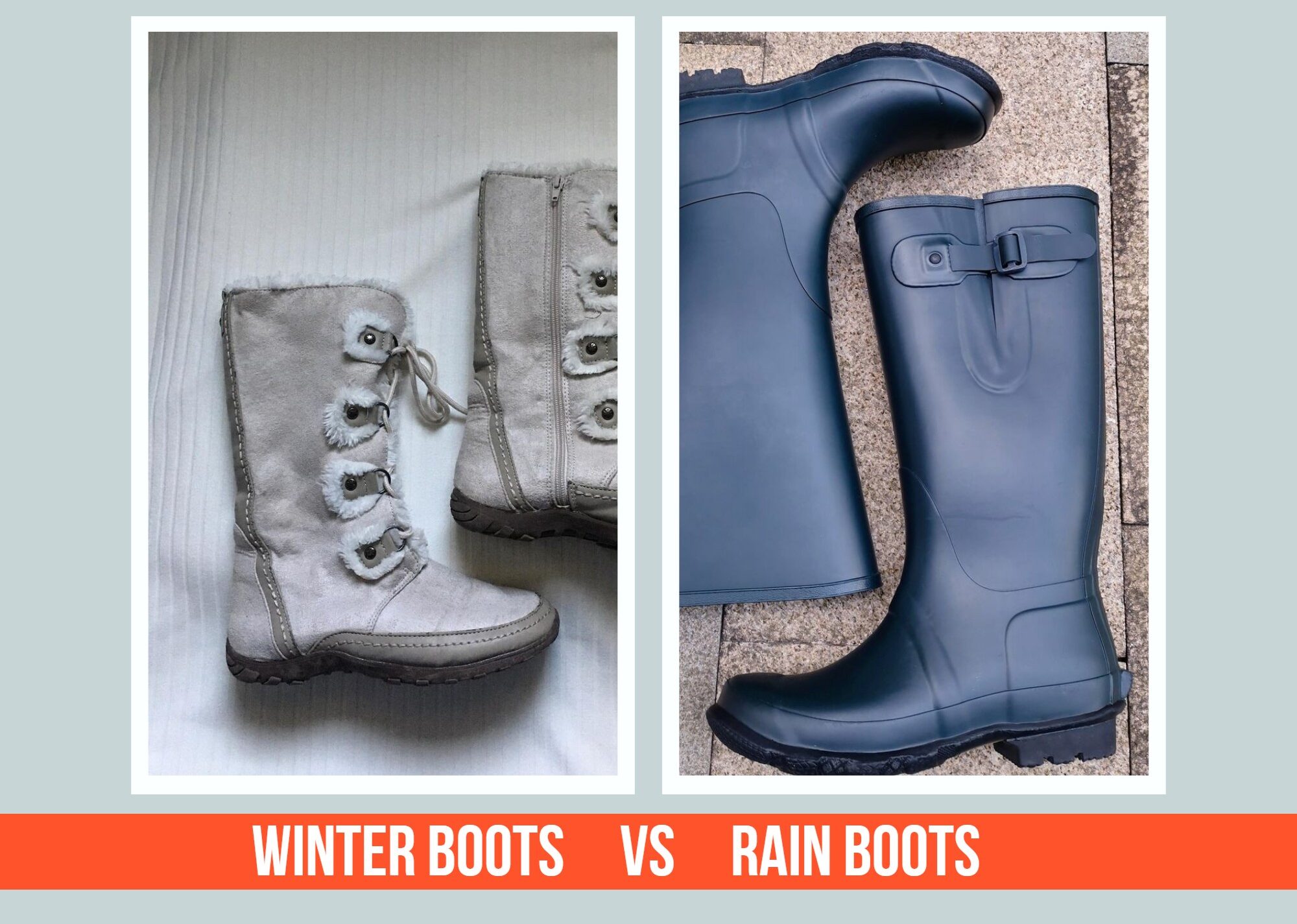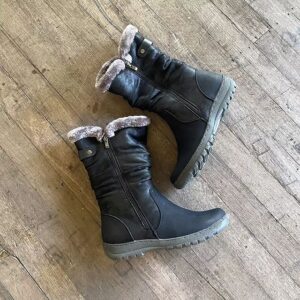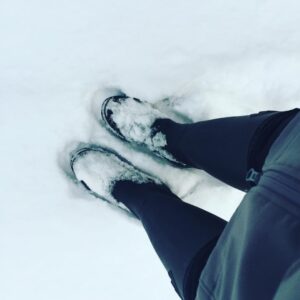Last Updated on September 2, 2022 by Sarah Jaffe

Rain boots and winter boots are often used interchangeably as the purpose of these boots is to protect your feet from weather conditions but often using them interchanging can be the cause of discomfort as well as a foot injury.
On the face of it, it may seem to be a matter of simple choice but the wrong choice of boots can be stressed. As history has shown, armies have lost wars because their boots did not provide enough weather protection.
Rain Boots
Essentially Rain boot is made of vinyl rubber or PVC plastic with rubber all made in a single mold with no stitching or joint in between the sole and upholstery upper part of the boot.
In this way, the boot is waterproof and its design is thigh-high so you may be walking in ankle-deep water but the feet will be dry.
Winter Boots
The winter boots have essentially rubber soles and are also of thigh height but the boots are made from mold just like rain boots but with better grip. 
From the ankle onwards it usually is made of faux leather, the main thing that differentiates the two is that it is padded with either quilting or even fur to keep the feet warm.
This is so as the feet are the body part that will have the most contact with the snow.
Rain Boots Vs. Winter Boots: What’s The Difference?
Whether it be rain boots or winter boots, they are purpose-specific outdoor boots that are to be worn according to the need. Both boots have a few distinct features that step them apart.
Rain boots are made from one single mold and a single material whereas winter boots are made of multiple parts made from different materials either stitched together or stuck together with glue.
Rain boots have a simple design, are open from the top, and normally do not have anything to tighten them up around the feet. Winter boots have laces or straps that are usually tied either on the ankles or the lower thigh.
Winter boots consist of nylon or fleece insulation and fancier ones have insulation of fur. The open end usually has circular padding. This blocks any air pocket and helps in letting the feet keep warm by not allowing any air in the boot.
Can you wear Rain Boots in winter?
Absolutely! In fact, many people prefer to wear rain boots in winter because they are more comfortable and protect your feet from the cold. You can wear thick socks with rain boots and add a pair of gloves to keep your hands warm. Or, you can add a puffy coat or scarf for extra warmth.
Although the material of rain boots prevents water from entering the boot and making your feet wet but these are relatively open boots, chills and cold of winter can easily enter into the boots. As it lacks any insulation to keep your feet warm it will keep the feet cold and not only it may cause discomfort but also if you are in the snow that is more than 2 feet deep it may become a cause of frostbite and may lead to hyperthermia.
Normally rain boots are made from glazed rubber on the outside so that they can repel water. In rain, its sole has enough grip that the person wearing it will not trip when walking in rainwater. In the early morning when the sun rises over snow it melts and forms a slippery glazed layer of water over it. The coefficient of friction on that slippery snow is very low such that rubber tires and PVC plastic lose their grip. So one can easily trip wearing rain boots on slippery snow.
Why You Shouldn’t Wear Rain Boots In The Winter?
Rain boots can prove to be a health hazard if not worn with any sort of insulation inside. To counter that issue, often what some people do is wear socks, fur, or leather sleeves on the feet and wear rain boots on top of it.
This technique may be effective for snowfall that is up to 2 feet deep but if the snow is knee-deep these very boots may become counterintuitive as your feet will be burdened by double the weight of boots as well as the snow that they displace, this happens so as rubber stiffens in sub-zero temperature.
The winter will put a toll on the feet as it will cause the freezing effect in the toes first and followed by that in the rest of the foot. If there is no mechanism for insulation, the feet will not be able to get warm and the boots will aid in keeping it cold as the rubber tends to get stiffer and allows colder to enter the boot.
When Should You Wear Rain Boots?
Rain boots are numerous other than only wearing them in the rain. The Wellington boot which is colloquially known as the rain boots were known as industrial boots.
From the late 19th century they were worn by the industrial worker, especially the ones that were dealing with chemicals, and other corrosive materials like iron because of the unreactive properties of galvanized rubber and protected the feet. Even in the hot environment of oil rigs these are still commonly used.
These are still used in muddy areas like excavation and still the most practical boots in rice paddies, hydroelectric technicians and municipal workers.
When Should You Wear Snow Boots?
Winter boots are generally worn in the snowy season, in the light snow ankle-high boots work very well because the task at hand is to keep the feet warm. But in heavy snowfall, the thigh-high is the game. These boots are called snow boots.
Interestingly the tracking boots also are similar to snow boots but when some snowy peak is to be submitted then the snow boots are worn with spikes fixed in the soles of it.
Rain Boots vs. Winter Boots — Which Pair Is Right For You?
Although it might seem obvious from the name that rain boots are for rain and winter boots for snowy cold weather but the devil is in the details. Rain boots have much more versatile use other than to protect feet from getting wet but they are protective boots for material things. These boots alone will not protect your feet from cold.
Winter boots not only cater for protection from weather conditions but also keep your feet dry. These are commonly worn while climbing mountains and trekking.
So rain boots are a cheap and easy alternative but the insulation must be acquired separately. Winter boots can do the deed for both, dry feet and cold but they are more expensive than others.
To cut the long chase short
Boots for rain and for winter have their specific purpose but now these are used more and more interchangeably. Now with the improvement in the quality of materials, the distinction between the two is weathering away.
So on winter days, winter boots can do the needful for your feet but in the hot and humid environment, they lose that advantage to rain boots.
In regards to rain boots and winter boots, please feel free to ask questions, voice concerns, or provide feedback. Do let us know your opinion as we will be delighted to know your opinion in the comments.

Sarah is the brains behind BootsNerd. Sarah Jaffe is a writer, editor, and boots lover based in Brooklyn, New York. She has done BA (Hons) in Footwear Design from De Montfort University, UK. She loves to write about boots and has a particular interest in vintage and sustainable fashion.